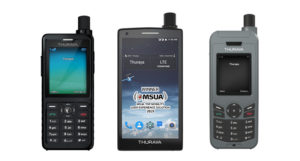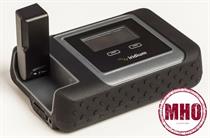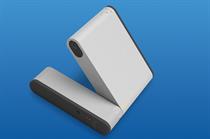When you’re watching a movie and you see someone making a call from a far-flung location with a bulky-looking phone with a massive chunky pull-out antenna on the top, that’s a satellite phone. They’re interesting devices that communicate via orbiting satellites which have none of the problems of ground-based cellular phones.
They’re also, traditionally, hellishly expensive. Not just in terms of hardware, but also in in calls. That’s not surprising, because these are not mass-market devices, and putting satellites in space is not exactly cheap. Indeed, it’s so expensive that it’s floored several companies in the past trying to establish global communications.
Things are changing now, and the Thuraya SatSleeve is going to help with that. This is an adaptor, into which you place your iPhone and, through some clever technology, it allows you to make calls via the Thuraya satellites in a very large percentage of the world.
Design
It’s quite likely that the first thing you’ll notice about the Thuraya SatSleeve is the large aerial on the top. Many people alive today won’t remember mobile phones that had aerials, especially pull-out aerials, but for satellite phones this remains essential to get enough gain to communicate with something in orbit.
The second thing you might notice is that the connection for a phone is the older Apple socket type, so that restricts this device to being used with an iPhone 4 or 4S for the time being. We’re told an iPhone 5 holster is coming very soon. We also discussed the idea of other phones being supported, say, select Android devices, and were told it was being considered. You don’t have to be an Apple fan to understand that this makes solid business sense.
On the back of the SatSleeve you’ll notice that there is a battery compartment. You can swap batteries, which we imagine will be essential for those trotting the globe. In the battery compartment, you’ll also find the SIM card slot, and a button for starting the Bluetooth pairing process.
On the bottom, there’s a USB socket, along with a power connector for the supplied charger. You can charge the Thuraya with USB too, but we imagine it’s a bit quicker with the non-standard socket. There’s also a neat feature, via a switch on the right, which can charge your iPhone. Doing this will drain the SatSleeve, which might cause problems. But it’s handy if you’re out of juice and need to get a call out urgently.
Although the SatSleeve connects to your iPhone via Bluetooth, it uses its own speaker and microphone for calls. This means you can still answer it when the iPhone is off the device, just press the SOS button. You can press it again to hang up. You can also program that button to call someone in an emergency. You enter the number via the app, so who it calls is up to you. Thuraya devices all have built-in GPS, so if you get lost, you’ll be locatable.
Coverage
Unlike some satellite phone operators, Thuraya doesn’t have total global coverage. This is a product of how it has deployed its communications satellites and how they orbit the planet.
Some companies, like Iridium, use lots of satellites which orbit high above the earth. These move through the sky, relative to Earth, very quickly. To make this work, Iridium needs 66 satellites running at any one time – it keeps spares in orbit in case of failure – and these satellites are in range for only a matter of seconds at a time, so when you’re in a call, the satellites must hand that call over to one another as they move out of range. This is similar to travelling very quickly through various ground-based cell towers.
While the system was designed to handle this, that’s still quite a lot to ask of a phone network and what’s more, it costs a lot of money to put 66+ satellites in orbit. Thuraya has gone down a different route, and uses two geostationary satellites to communicate with its phones.
The first of these, and the one relevant to the UK, Europe, the middle-east and Africa, hovers above the Earth in a location that’s not all that dissimilar to Sky’s orbital position on the Astra satellites. This is handy in one way, because UK users will be able to locate the rough position of the satellite by looking where all the Sky dishes are pointing.
But it also causes some problems for users who are in built-up areas. Namely, if the phone can’t see the sky to the south, you won’t get a signal. We discovered this in Prague, where we couldn’t get the device to lock on at all. Now, obviously, the phone wasn’t designed for this sort of use. Satellite phones grew up in remote locations like deserts, countries in the developing world with no fixed or cell phone infrastructure and places where no other signal can reach, like at sea or on remote oil rigs.
Thuraya doesn’t have a satellite that covers the Americas either. Meaning you can’t make calls from the US, Canada, Mexico, or anywhere in Central or South America. Thuraya has recently done a deal with T-Mobile to get some roaming coverage there, but that sort of goes against the point of a satellite phone.
There is also a small hiccup with India, which has taken against satellite phonesafter some problems with terrorism. The country wants to legislate against them, but Thuraya doesn’t agree. You now can’t buy any Thuraya hardware in India, and there are restrictions on taking devices in to the country.
Very simple
While using a satellite phone might sound very complicated, the actual process with the SatSleeve is really simple. The sleeve itself is divided into two parts: a simple and cheap to replace holster for the iPhone and the electronics on to which the first piece is attached.
To get the iPhone to work with the SatSleeve, you need to pair them via Bluetooth. This is a simple process and takes just a few seconds. All of the iPhones we tested found the SatSleeve straight away.
Once paired, you download the app via the iTunes store and if your phone and SatSleeve are paired you’ll see it show up in the app. You select the device, then you’re presented with a signal strength screen. Along the bottom are icons for dialling, text messaging and settings. It’s much like a regular phone, but within an app of its own.
Call quality
Here, we admit to be being surprised. The Thuraya was actually a very nice device from which to make a call, and far less hassle than we expected. Calls were really clear, far more so than anticipated, and had minimal lag. There will always be some delay because, after all, this phone calls via space, yes – SPACE!
We did notice that calls were subject to some break-up if you moved much. Even pivoting slightly on the spot caused this. It’s probably best if you stay still when on a call, and try to keep the antenna pointed in the right general direction too.
Things to remember include putting + and the country code in front of the number you’re calling. This is sort of obvious guess. Text messages are simple too, and are delivered really quickly. We were very impressed.
Roaming
Roaming sounds a bit weird when you’re talking about a technology that knows little about geographic boundaries. But, with the lack of coverage across the American continent(s) means that the firm needed a plan, and the result is actually very clever indeed.
Like all phones, the SatSleeve comes with a normal-sized SIM card. This means that you can pop it out and place it any phone with a regular SIM card socket. When you do this, you are basically roaming on a 3G network in the same way you would with a UK phone in, say, the US. It’s a clever idea and handy if you rely on your number, but need to go to the US.
Also, it’s possible for other operators to do deals with Thuraya to enable roaming on its network on their accounts. So, if you were trekking across Mongolia, then you could rent a Thuraya device, pop your SIM card in it, and roam away. It would be slightly more expensive of course, but to save on the cost of buying a satellite phone, it’s probably worth it.
No data – yet
One of the unique things about Thuraya is that it can deliver satellite internet at speeds quite far ahead of most satellite phone systems. In theory, you could download at 500kbps, which isn’t broadband quick, but it’s more than enough for use in far-flung places. Journalists have used this sort of tech for reporting from war zones, where using 3G is just too dangerous.
There’s no data here though, but the firm does have a Wi-Fi model planned that will allow you to surf using the Sleeve as a hotspot. We don’t have firm dates for when that will launch though.
Call costs
The call packages are hard to talk about with great accuracy. The problem is, Thuraya doesn’t sell directly to customers, it has service providers who do that, and so all can charge you differently. This is very much like the old UK mobile network days, which were also a bit clumsy. To add to that, there is also a “unit” rate, which obfuscates slightly the actual cost.
However, to make a call on the pay as you go SIM we used was about $1.35 to call another Thuraya phone and about $2 to call most of the rest of the world. There are some countries where calls are a lot more expensive, but these are far-flung and not especially common. Text messages cost about $0.80.
Battery life
Thuraya says you’ll get about two days standby out of the SatSleeve and around four hours talktime. We think this about right, but calling someone for four hours was beyond the scope of the credit on our SIM card, so we didn’t. It lasted well though, and we assume most will use it with a normal phone, so it will get sporadic use.
Charging takes about three hours, but as we said, you can easily buy spare batteries if you’re worried about running out of juice.
Verdict
At £400 the SatSleeve is expensive. The call costs are far from bargain-basement too, but if you need to be reachable in almost any location on earth, then this could be the device for you. Prices are on the way down too, which means satellite calling could be in reach for almost anyone.
The lack of service in the Americas is a problem too. If you’re going to go down the satellite phone route, you’re going to want global coverage. Of course, there’s still loads of places you can use this device, and it’s bound to be very helpful for some people.
If nothing else, this technology is very cool. We’re looking forward to the internet-ready version, and we think the iPhone 5 mount will make it even more attractive. Is this for everyone? No, but for those who have a real need, it’s very worthwhile.
Our sincere thanks to O2 who lent us an iPhone 4S for this test.
Article originally published on Pocket-lint.com by Ian Morris.


